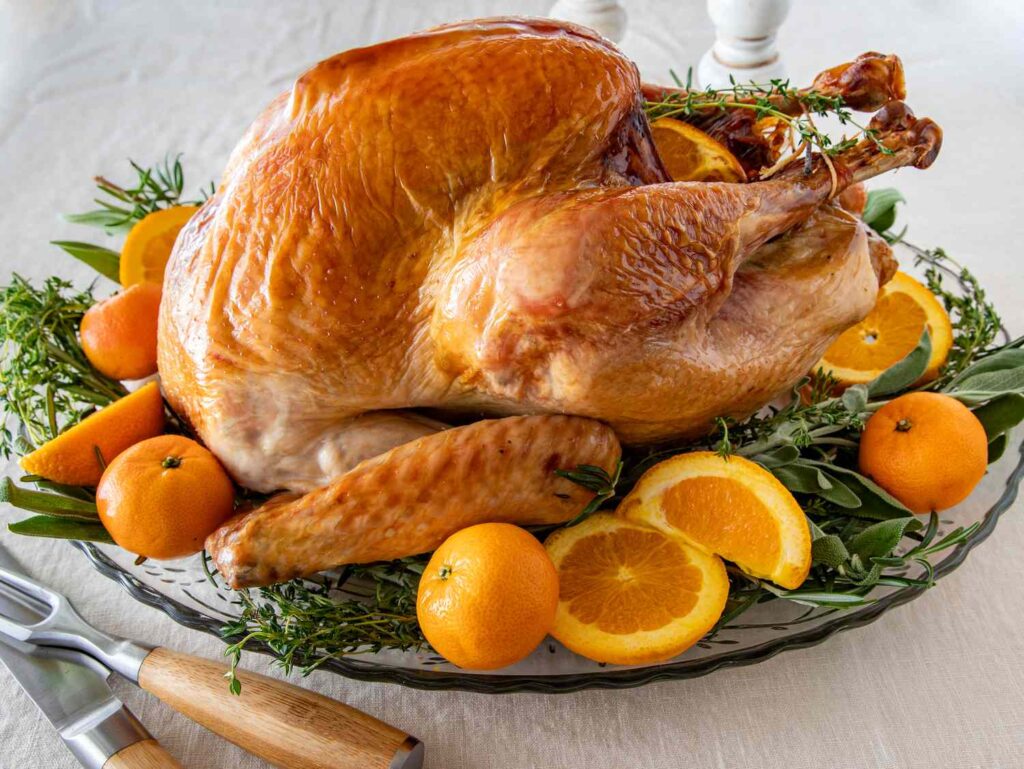1. You wait too long to buy a turkey.
If you’re buying a frozen, conventional turkey (like Butterball) from the supermarket, buy it 1-2 weeks in advance and store it in your freezer.
If you’re buying a fresh turkey (conventional OR free range organic) from the supermarket, you can’t pick it up too far ahead of time, because it’ll go bad. But you can and should call the supermarket to reserve your fresh turkey at least two weeks in advance.
If you’re ordering a super fancy turkey, such as a Heritage turkey, order online at least a month in advance. The turkey will be delivered to you the Tuesday before Thanksgiving.
2. You forget that a frozen turkey takes FOUR DAYS to thaw.
The best way to thaw your turkey is in the refrigerator, where a turkey thaws at a rate of 4 pounds per day. So, a 16-pound turkey will take four days to thaw.
If it’s already too late and you need to thaw your turkey ASAP, here’s how.
3. You don’t realize that many turkeys are pre-brined.
That frozen Butterball “Contains up to 8% of a solution of Water, Salt, Spices, and Natural Flavor.” That means Butterball did the brining already in order to extend the shelf life of the turkey. The same is true for kosher turkeys, so always check the ingredient list, and if there’s already salt injected into your turkey, don’t brine it.
4. You don’t let your turkey come to room temperature before roasting it.
Don’t roast a cold turkey. Take your bird out of the refrigerator (and out of the brine, if you’re brining) an hour before you put it in the oven to ensure even cooking and a moist bird.
5. You don’t dry the turkey really well inside the cavity and on the outside.
Drying your turkey thoroughly with paper towels helps crisp the skin.
Drying inside the cavity is important, too, and most people forget about it.
6. You don’t salt inside the cavity.
If you don’t brine your turkey, you need to season it thoroughly. It’s easy to forget about the inside of the turkey, but sprinkling salt in the cavity seasons the meat from the inside.
7. You don’t use a roasting rack inside your roasting pan.
Without a rack, the meat on the bottom of your bird will end up overcooked and dry, the skin will burn, and your kitchen will fill with smoke. Invest in a roasting pan with a rack. It’s not like you’ll only use it on Thanksgiving; the best roast chickens are cooked on a rack, too.
You can get a good, cheap roasting rack here ($24). Or, if you want something higher quality, this All-Clad roasting pan ($100) is great.
8. You cook stuffing inside the bird.
It means you have to cook the turkey longer to get the stuffing cooked through — otherwise, it’s basically salmonella bread pudding — which means the turkey’s meat will be dry and less tasty.
9. You roast the turkey at one temperature, instead of starting it in a really hot oven and then lowering the heat.
Roast your turkey at 475°F for the first 30 minutes, and you’ll crisp the skin byrendering the fat out quickly. After 30 minutes, turn down your oven temperature to 350°F for the remainder of the cooking time.
10. You freak out about the skin browning too quickly and turn down the oven temperature.
If you notice that the skin of your turkey is getting too dark, just take it out of the oven and lay a piece of aluminum foil over the areas that are about to burn. Don’t change the oven temperature.
11. You baste.
STOP IT. Reasons:
1. Every time you open the oven door, your oven loses heat, and your turkey takes longer to cook, and the more it dries out.
2.The pan drippings that you baste with aren’t 100% fat; they are a mixture of fat and liquid, and that liquid will actually make your turkey skin soggy and dry your meat out.
3. It’s a pain and takes up valuable time that you could spend mashing potatoes or watching football.
12. You don’t use a real thermometer:
WRONG:
Often, your turkey will come with a pop-up thermometer already inserted into its breast meat. Take it out and throw it away. Pop-up thermometers are inaccurate, and many of them are set to “pop up” at 180 degrees, at which point your turkey will be overcooked.
RIGHT:
A real meat thermometer is essential, because it tells you the exact internal temperature of your bird. So, if you take its temperature and your thermometer reads 155, you know it’s almost done.
If you want a digital thermometer, this one is great and only costs $15. If you’re comfortable with an analog thermometer (really they’re just as easy to use), try this one, $12.
13. You check the temperature at the wrong time, in the wrong place.
WHEN SHOULD YOU START CHECKING THE TEMPERATURE?
For a 14- to 16-pound turkey, check the temperature after 2.5 hours. For an 18- to 20-pound turkey, check the temperature after three hours. If it isn’t done, check again every 15 minutes.
WHERE SHOULD YOU CHECK THE TEMPERATURE?
Your thermometer needs to be in the thickest part of the thigh. Insert the thermometer right where the thigh meets the breast, and push it in until you feel it slide into the thigh meat.
14. You cook the turkey past 165°F.
Stop doing that. Don’t cook your turkey to 180°F; it’ll be dry. A turkey is safe to eat when cooked to 165°F. Some chefs recommend only cooking poultry to 160°F since meat will continue to cook after you take it out of the oven.
15. You don’t let your turkey rest for at least 15 minutes before carving.
You need to wait at least 15 minutes after taking the bird out of the oven before you cut into it, so that the juices inside the turkey have time to settle into the meat instead of pouring out onto your cutting board and leaving you with a dry bird (and a mess).
16. You destroy the turkey when it comes time to carve it.
17. You carve up the whole bird even though only half of it will get eaten on Thanksgiving.
If you’re serving dinner for eight people or fewer, only slice one leg and one breast. Store the other leg and breast, uncut, in an airtight container in the fridge, and slice pieces off as you’re ready to eat them; unsliced meat doesn’t dry out as quickly.

